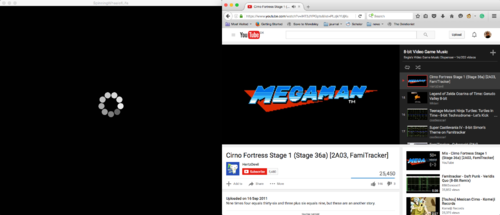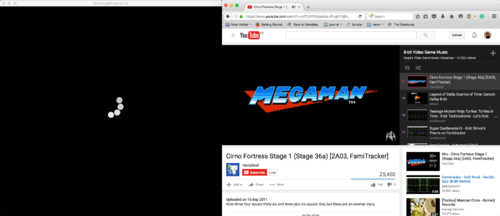Difference between revisions of "Exe0.2 Winnie Soon"
| Line 16: | Line 16: | ||
>> [side note]The title of the project is borrowed from a ‘wait cursor’ in the Macintosh Operating System X designed by Apple. The wait cursor is colloquially known as “The Spinning Wheel of Death”, referring to the malfunction or failure of a running program or a system that leads to screen freezes. The name takes on negative connotations as the problems are usually difficult to diagnose. | >> [side note]The title of the project is borrowed from a ‘wait cursor’ in the Macintosh Operating System X designed by Apple. The wait cursor is colloquially known as “The Spinning Wheel of Death”, referring to the malfunction or failure of a running program or a system that leads to screen freezes. The name takes on negative connotations as the problems are usually difficult to diagnose. | ||
Reference: | |||
Ernst, W. (2006). Dis/continuities: Does the Archive Become Metaphorical in Multi-Media Space? In W. H. K. Chun & T. Keenan (Eds.), New media, old media : a history and theory reader (pp. x, 418 sider). New York ; London: Routledge. | |||
Laplante, P. A. (2000). Dictionary of Computer Science, Engineering and Technology CRC Press. | |||
'''Screenshots:''' | '''Screenshots:''' | ||
Revision as of 15:38, 19 April 2016
Spinning Wheel of Life (2016)
This work draws upon my previous working article from exe0.1- [At the time of execution: throbber.start()]
Description:
The project challenges the perception of a throbber that is usually understood as a transitional object in contemporary software culture. Forcing to focus on the Spinning Wheel of Life with a music stream, how might we engage with a throbber beyond the negative connotations of waitings, frustrations and annoyance?
Data is streamed through different speeds and sites across network connections, devices and nodes. The work reveals the microtemporality of streamed data that is not often made visible to us. Instead of presenting a throbber that spins at a constant speed, the project makes apparent the real-time network traffic at a microscopic level through the display of repetitive but different tempo of ellipses. Computationally, by forcing the software program to pick up the real-time packets, it might enable us to conceive a stream of discontinuity.
Considering a stream produces differences and rhythms, the work takes the strategy of slowing down and minimising data size to capture the background processes of synchronisation, operations and executions. Buffering is a coupling of storage and transfer (Ernst, 2006, p. 108), and a buffer is a temporary memory in which writing and reading data are in different rate (Laplante, 2000, p. 55). More precisely, the viewer is not watching or listening to the content as data arrives, instead, the viewer is experiencing the processed data that has arrived and stored in the buffer. There is latency between data arrival, data storage and data processing.
The Spinning Wheel of Life addresses multiple executions occur along a network journey. There are different rates, tempo, pulses, pauses and rhythms at multiple scales - from the operations of the CPU to network routers, from the transmissions of senders to receivers, from the writing to the reading of buffer, and from continuous streams to discontinuous packets. The Spinning Wheel of Life is a reflection on the microtemporal complexity of operative processing, constantly rendering the now in this pervasive and networked conditions of contemporary software culture.
>> [side note]The title of the project is borrowed from a ‘wait cursor’ in the Macintosh Operating System X designed by Apple. The wait cursor is colloquially known as “The Spinning Wheel of Death”, referring to the malfunction or failure of a running program or a system that leads to screen freezes. The name takes on negative connotations as the problems are usually difficult to diagnose.
Reference: Ernst, W. (2006). Dis/continuities: Does the Archive Become Metaphorical in Multi-Media Space? In W. H. K. Chun & T. Keenan (Eds.), New media, old media : a history and theory reader (pp. x, 418 sider). New York ; London: Routledge.
Laplante, P. A. (2000). Dictionary of Computer Science, Engineering and Technology CRC Press.
Screenshots:
Video documentation (work in progress):
4 mins video [here]
Video stream: https://www.youtube.com/watch?v=dXb3XXi9Xww&list=PLzjkiYUjXuevVG0fTOX4GCTzbU0ooHQ-O&index=12
Date: 18 Apr 2016, 15.30 - Aarhus, Denmark
Ideal setup and how it works:
Ideally, it is an installation work that displays the visual on screen and comes with a headphone. A dynamic throbber is visually presented (only a throbber but no youtube screen) and an audience will hear the youtube 8-bit video game music playlist, and both are run in real time.
How it works: A software is made in processing, constantly listening to a range of IP addresses in real-time. Each display of an ellipse is subjected to network packet arrival. A series of the ellipse will form a noticeable and animated icon - throbber.

